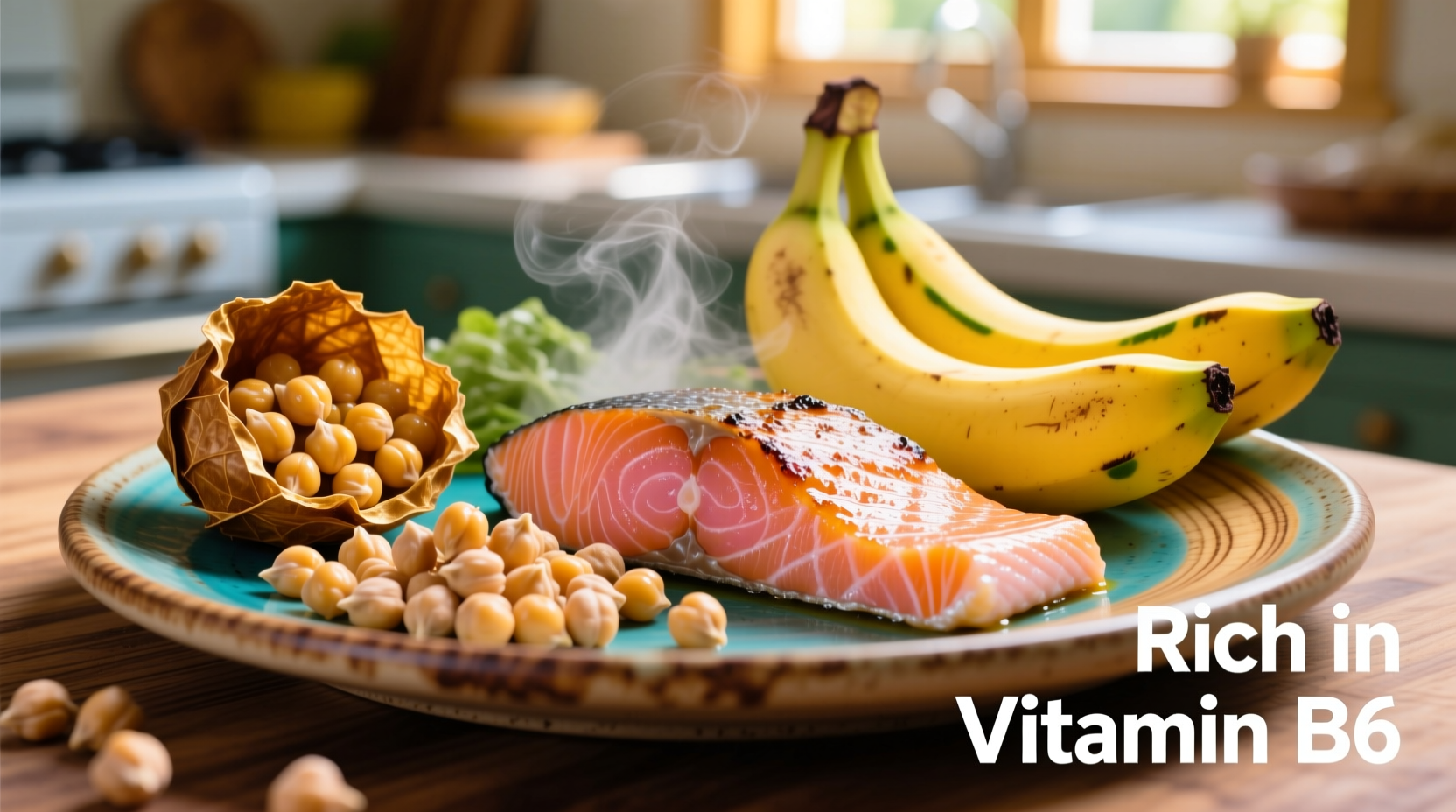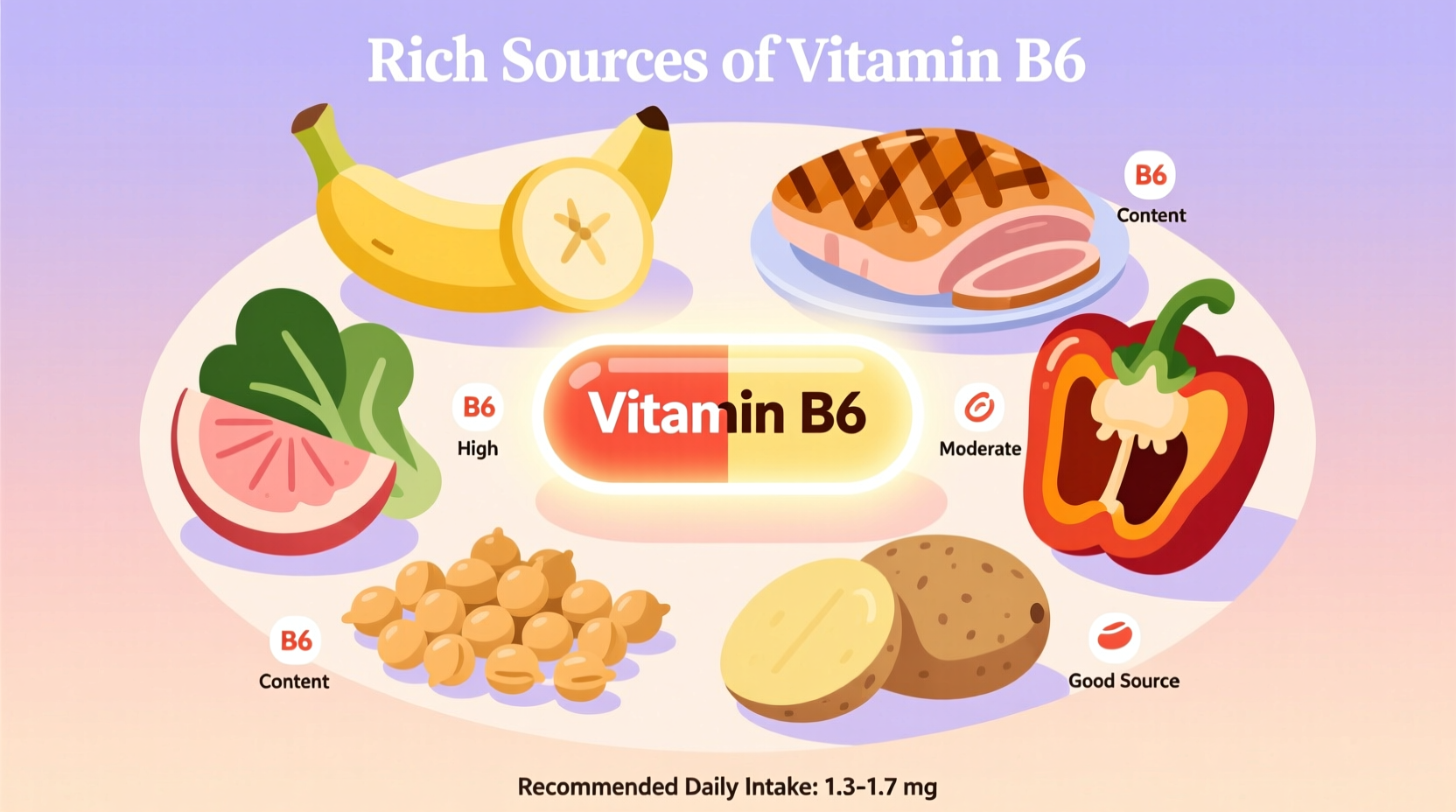Top Vitamin B6 Foods: Your Complete Guide to Boosting Intake Naturally
Discover exactly which foods deliver optimal vitamin B6 levels to support your metabolism, brain function, and immune system. This guide cuts through the noise with science-backed recommendations you can implement immediately.
Why Vitamin B6 Matters More Than You Think
Vitamin B6 (pyridoxine) isn't just another nutrient—it's a metabolic powerhouse involved in over 100 enzyme reactions. According to the National Institutes of Health, this essential vitamin helps your body convert food into energy, create neurotransmitters, and maintain healthy red blood cells. Deficiency can cause fatigue, confusion, and weakened immunity—yet many people fall short of daily requirements.
Top 10 Vitamin B6 Power Foods Ranked by Nutrient Density
These vitamin B6-rich foods deliver maximum benefits per serving. All values based on USDA FoodData Central measurements for standard serving sizes:
| Food | Serving Size | Vitamin B6 (mg) | % Daily Value |
|---|---|---|---|
| Chickpeas (cooked) | 1 cup | 1.1 | 65% |
| Salmon (wild, cooked) | 3 oz | 0.6 | 35% |
| Chicken breast (cooked) | 3 oz | 0.5 | 29% |
| Potato (with skin) | 1 medium | 0.4 | 24% |
| Banana | 1 medium | 0.4 | 24% |
| Tuna (canned in water) | 3 oz | 0.3 | 18% |
| Beef liver (cooked) | 3 oz | 0.3 | 18% |
| Sunflower seeds | 1/4 cup | 0.3 | 18% |
| Avocado | 1/2 medium | 0.2 | 12% |
| Fortified breakfast cereal | 1 serving | 0.2-2.5 | 12-150% |
Chickpeas stand out as the clear winner for plant-based diets, providing more vitamin B6 per serving than any other commonly consumed food. This explains why Mediterranean and Middle Eastern diets—rich in legumes—show lower rates of B6 deficiency according to research published in Nutrients journal.
How Cooking Methods Impact Vitamin B6 Retention
Vitamin B6 is water-soluble and heat-sensitive, but smart preparation preserves maximum nutrients:
- Steaming beats boiling—retains 20-30% more B6 in vegetables like potatoes
- Quick roasting preserves B6 better than prolonged high-heat cooking
- Raw consumption maximizes B6 in foods like bananas and avocados
- Avoid excessive soaking of legumes which leaches water-soluble vitamins

Who Needs More Vitamin B6? Special Population Requirements
Daily requirements vary significantly across demographics. The NIH established these science-based recommendations:
- Adults 19-50 years: 1.3 mg daily
- Men 51+: 1.7 mg daily
- Women 51+: 1.5 mg daily
- Pregnant women: 1.9 mg daily
- Nursing mothers: 2.0 mg daily
Certain medical conditions increase requirements, including Mayo Clinic research showing that people with kidney disease, autoimmune disorders, or those taking certain medications (like isoniazid for tuberculosis) often need supplemental B6 under medical supervision.
3-Day Vitamin B6 Meal Plan for Optimal Intake
Implement these realistic eating patterns to consistently meet your daily needs:
Day 1
- Breakfast: Fortified cereal (1.5 mg) + banana (0.4 mg)
- Lunch: Chickpea salad (1.1 mg) + avocado (0.2 mg)
- Dinner: Baked salmon (0.6 mg) + roasted potatoes (0.4 mg)
- Total: 3.8 mg (224% DV)
Day 2
- Breakfast: Scrambled eggs with potatoes (0.5 mg)
- Lunch: Chicken wrap (0.5 mg) + banana (0.4 mg)
- Dinner: Lentil soup (0.7 mg) + whole grain bread
- Total: 2.1 mg (124% DV)
Day 3
- Breakfast: Oatmeal with sunflower seeds (0.3 mg)
- Lunch: Tuna salad sandwich (0.3 mg) + potato chips (0.2 mg)
- Dinner: Beef stir-fry with bell peppers (0.4 mg) + brown rice
- Total: 1.2 mg (71% DV)
Vitamin B6 Deficiency: Warning Signs You Shouldn't Ignore
While severe deficiency is rare in developed countries, marginal insufficiency affects up to 10% of adults according to CDC National Health and Nutrition Examination Survey data. Watch for these subtle symptoms:
- Micronutrient deficiency-related fatigue that doesn't improve with rest
- Mood changes including increased anxiety or depression
- Mild cognitive difficulties like brain fog or memory lapses
- Cracks at the corners of the mouth (cheilosis)
- Weakened immune response with frequent infections
These symptoms often develop gradually, making them easy to dismiss. If you experience multiple symptoms persistently, consult a healthcare provider for proper testing rather than self-supplementing.
Common Questions About Vitamin B6 Foods
Which fruit has the most vitamin B6?
Bananas contain the highest vitamin B6 content among common fruits (0.4 mg per medium banana), followed by avocados (0.2 mg per half fruit) and mangos (0.2 mg per cup). Citrus fruits contain minimal B6 compared to these options.
How can vegetarians get enough vitamin B6?
Vegetarians can meet vitamin B6 needs through chickpeas (1.1 mg per cup), potatoes (0.4 mg each), sunflower seeds (0.3 mg per 1/4 cup), bananas (0.4 mg each), and fortified cereals. Combining these throughout the day easily reaches the 1.3-1.7 mg daily requirement.
Does cooking destroy vitamin B6 in foods?
Yes, but not completely. Vitamin B6 is water-soluble and heat-sensitive, so boiling causes the most loss (up to 50%). Steaming, roasting, or quick cooking preserves more nutrients. Raw consumption maximizes B6 retention in foods like bananas and avocados.
What happens if you don't get enough vitamin B6?
Chronic deficiency can cause anemia, depression, confusion, weakened immune function, and skin rashes. Severe deficiency may lead to neurological symptoms. Most people can prevent deficiency through diet alone—supplements should only be taken under medical supervision due to potential toxicity at high doses.
How much vitamin B6 is in eggs?
One large egg contains approximately 0.1 mg of vitamin B6, primarily in the yolk. While not a top source, eggs contribute to daily intake when combined with other B6-rich foods like potatoes or fortified cereals in breakfast meals.











 浙公网安备
33010002000092号
浙公网安备
33010002000092号 浙B2-20120091-4
浙B2-20120091-4